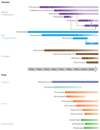Drug resistance in eukaryotic microorganisms
- PMID: 27572976
- PMCID: PMC5215055
- DOI: 10.1038/nmicrobiol.2016.92
Drug resistance in eukaryotic microorganisms
Abstract
Eukaryotic microbial pathogens are major contributors to illness and death globally. Although much of their impact can be controlled by drug therapy as with prokaryotic microorganisms, the emergence of drug resistance has threatened these treatment efforts. Here, we discuss the challenges posed by eukaryotic microbial pathogens and how these are similar to, or differ from, the challenges of prokaryotic antibiotic resistance. The therapies used for several major eukaryotic microorganisms are then detailed, and the mechanisms that they have evolved to overcome these therapies are described. The rapid emergence of resistance and the restricted pipeline of new drug therapies pose considerable risks to global health and are particularly acute in the developing world. Nonetheless, we detail how the integration of new technology, biological understanding, epidemiology and evolutionary analysis can help sustain existing therapies, anticipate the emergence of resistance or optimize the deployment of new therapies.
Conflict of interest statement
The authors declare no competing financial interests.
Figures


References
-
- Woolhouse M, Farrar J. Policy: an intergovernmental panel on antimicrobial resistance. Nature. 2014;509:555–557. - PubMed
-
- Fernandez FM, Green MD, Newton PN. Prevalence and detection of counterfeit pharmaceuticals: a mini review. Ind Eng Chem Res. 2008;47:585–590.
-
- Nayyar GM, Breman JG, Newton PN, Herrington J. Poor-quality antimalarial drugs in southeast Asia and sub-Saharan Africa. Lancet Infect Dis. 2012;12:488–496. - PubMed
Publication types
MeSH terms
Substances
Grants and funding
LinkOut - more resources
Full Text Sources
Other Literature Sources
Medical

